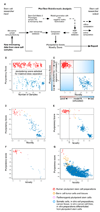A bioinformatic assay for pluripotency in human cells
- PMID: 21378979
- PMCID: PMC3265323
- DOI: 10.1038/nmeth.1580
A bioinformatic assay for pluripotency in human cells
Abstract
Pluripotent stem cells (PSCs) are defined by their potential to generate all cell types of an organism. The standard assay for pluripotency of mouse PSCs is cell transmission through the germline, but for human PSCs researchers depend on indirect methods such as differentiation into teratomas in immunodeficient mice. Here we report PluriTest, a robust open-access bioinformatic assay of pluripotency in human cells based on their gene expression profiles.
Figures


Comment in
-
Testing pluripotency.Nat Methods. 2011 Apr;8(4):287. doi: 10.1038/nmeth0411-287. Nat Methods. 2011. PMID: 21574272 No abstract available.
References
-
- Daley GQ, Lensch MW, Jaenisch R, et al. Cell Stem Cell. 2009;4(3):200. - PubMed
-
- Takahashi K, Yamanaka S. Cell. 2006;126(4):663. - PubMed
-
- Müller FJ, Goldmann J, Loser P, et al. Cell Stem Cell. 2010;6(5):412. - PubMed
-
- Russell WMS, Burch RL. The Principles of Humane Experimental Technique. London: Methuen; 1959.
Publication types
MeSH terms
Grants and funding
LinkOut - more resources
Full Text Sources
Other Literature Sources
Research Materials

